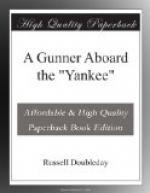Heroes all!
* * * * *
During the afternoon of our arrival, when we finally secured time to look about us, we were struck with the appearance of the really formidable fleet of warships collected under Admiral Sampson’s flag. For size of individual ships and weight of armor and armament, there had never been anything in the history of the United States to equal it.
The fleet consisted of the powerful battleships “Iowa,” “Indiana,” “Massachusetts,” and “Texas,” the two splendid armored cruisers “New York” and “Brooklyn,” cruisers “New Orleans” and “Marblehead,” converted yachts “Mayflower,” “Josephine,” and “Vixen,” torpedo boat “Porter,” cable boat “Adria,” gunboat “Dolphin,” and the auxiliary cruisers “St. Louis” and “Yankee.”
The vessels formed a semicircular line, completely enclosing the entrance to Santiago harbor. From where the “Yankee” rested, on the right wing, a fine view of the coast could be obtained. Two insurgent camps were plainly visible—one on the beach and another in the hills, which at that point rose to the height of fully four thousand feet. Morro Castle, a grim, sullen, gray embattled fort, directly overlooking the channel, was in plain sight, and here and there could be seen little green or sand-colored mounds, marking the site of earthworks.
The stretch of blue sea, edged by the tumbling surf-beaten beach, and the uprising of foliage-covered hills, all brought out clearly by a tropical sun, formed a picture as far removed from the usual setting of war as could be. But war was there, and the scenery appealed to few. There was more interest in the drab hulls of the fleet and the outward reaching of the mighty guns.
That evening—the evening of June 3d—the “Yankee’s” decks presented an animated spectacle. The novel surroundings and the prospect of action kept the boys interested. The “Rumor Committee” was in active session, and one of its principal members, the captain’s orderly, brought the news forward that the auxiliary cruiser would surely lead a procession of battleships into Santiago harbor the following day.
This was a little too strong for even the marines to swallow. We lay down by our loaded guns that night, feeling that it was well to be within easy reach of our defenders.
Hammocks were laid on the deck close to each five-inch breechloader, and the regular watch was doubled. Lack of experience made all these warlike preparations very impressive, and it was some time before the boys fell asleep. For my part, such a restlessness possessed me that, after trying to woo slumber for a half hour, I left my place and crawled over nearer the open port.
“Hello, Russ,” whispered a voice, apparently from the outside. “Just lean out here if you want to cool off. Isn’t the night air fine?”
A small figure wriggled in from where it had been hanging over the port sill, and in the faint light I recognized “Kid,” as we called him, the smallest boy on board, and so pleasant and popular that we had unanimously elected him the mascot of the ship.




